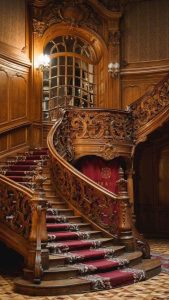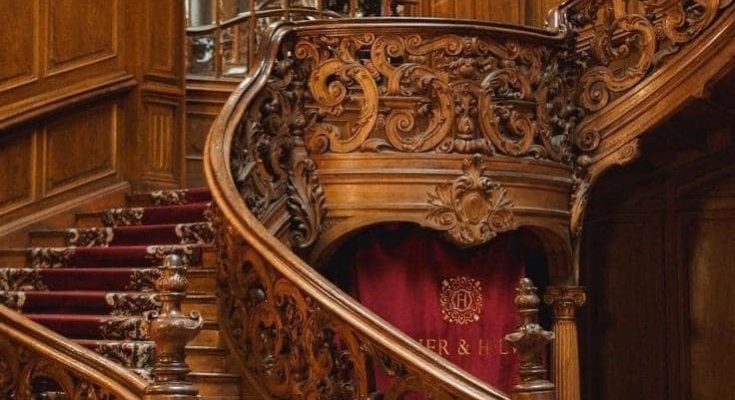A beautiful carved staircase can be a striking focal point in any home or building, blending craftsmanship with elegance. Whether you’re envisioning a grand, sweeping staircase in a historic mansion or a more subtle, intricate design for a smaller space, there are several ways to enhance its beauty through design and material choices. Here are some ideas and elements to consider when describing or designing a carved staircase:
1. Wood Carvings:
Wood is a traditional material for staircase construction, offering warmth and the ability to be intricately carved. Popular wood types for carved staircases include:
Oak: Strong and durable, oak can be carved into intricate designs, often seen in grand homes.
Mahogany: Offers a rich, reddish-brown hue, lending an air of sophistication.
Cherry: Known for its fine grain and smooth texture, cherry wood develops a beautiful patina over time.
Carvings can be delicate or bold, including motifs such as scrolls, floral designs, animals, or even geometric patterns. Balusters, newel posts, and handrails can all be richly detailed.
2. Spindle Design:
The spindles (or balusters) that line the sides of the staircase can be carved in a variety of styles. From classical, twisting, and fluted designs to more modern interpretations, these elements can make the staircase look ornate or contemporary. Intricate spindles, such as those with detailed acanthus leaves, create a timeless, luxurious feel.
3. Newel Posts:
These are the central supporting columns at the base and top of a staircase, and they can be incredibly ornate. Carved newel posts often feature detailed motifs, such as:
Scrolled flourishes that spiral around the post.
Geometric patterns or rosettes for a more minimalist yet still artistic design.
Figural carvings: Some newel posts even feature figures or busts for a more dramatic effect.
4. Handrails:
A carved handrail adds a touch of refinement to the staircase. Handrails can be carved to complement the style of the staircase and can include:
Fluted handrails for a traditional look.
Rope twists for a nautical or rustic touch.
Leaf motifs for a more organic and natural appearance.
Intricate relief carvings, incorporating symbols, family crests, or ornate scrollwork.

5. Stair Treads:
Carved stair treads can add beauty and texture to the staircase. These are often finely detailed with inlay or woodburning patterns, floral motifs, or other decorative flourishes. If you prefer a more minimalistic aesthetic, carved edges with subtle designs can add a sophisticated touch.
6. Finish and Detailing:
Carved staircases are often finished with high-quality stains or varnishes to highlight the natural wood grain. Dark stains, like walnut or ebony, offer a dramatic, classic look, while lighter finishes (like honey oak or maple) bring a more airy, rustic feel. A high-gloss finish can make the carvings stand out and add visual depth, while a matte finish provides a more understated elegance.
7. Architectural Style Considerations:
Baroque and Rococo Styles: These styles tend to have ornate, lavish carvings with sweeping, dramatic flourishes.
Victorian Style: Features detailed woodwork with intricate floral and geometric patterns.
Colonial or Georgian Style: Focuses on more restrained, classical carvings, like fluted columns and square balusters.
Modern or Minimalist Style: Carvings are simpler, often emphasizing clean lines or subtle, geometric elements.
8. Staircase Shape and Design:
Spiral Staircases: Carved spiral staircases are particularly stunning when the balustrades and newels follow the curvature of the steps, creating a fluid, graceful effect.
Curved or Winding Stairs: These staircases naturally lend themselves to intricate carving because the graceful flow allows for elaborate detailing in the handrail and balusters.
Floating or Cantilevered Stairs: For a modern take, floating stairs with carved handrails or detailed under-steps can be visually stunning.
9. Lighting Integration:
Incorporating lighting into the design of a carved staircase can further highlight its beauty. For example,:
Recessed lighting or pendant lamps can cast soft shadows on the carvings, accentuating their depth and detail.
Wall sconces along the staircase can illuminate carved elements on the walls or newel posts.
10. Historical Inspiration:
If you’re going for a historical or period-inspired look, consider drawing inspiration from famous historical carved staircases, like:
The double helix staircase in the Vatican Museums, which is an architectural marvel with its spiraling form and bold design.
The Louvre Museum in Paris, known for its grand, sculptural staircase leading to the main galleries.
Examples of Beautifully Carved Staircases:
Grand Staircases in Historic Mansions: These typically feature large, intricately carved newel posts, elaborate spindles, and sweeping handrails, all crafted from rich hardwoods like mahogany or oak.
Victorian Staircases: Often have ornate, swirling patterns and embellishments, with carved details on the newel posts and balusters.
Baroque Staircases: Highly detailed, with opulent carvings including leaves, scrolls, and often large central pieces like sculptures in the newel post or spindles.
Final Touches:
A carved staircase is more than just a set of steps—it’s a work of art. To complement the beauty of the staircase, surrounding elements like rugs, furniture, and artwork should harmonize with the architectural details. Whether you prefer a rustic, hand-carved charm or a more polished, grand design, a beautifully crafted staircase can elevate any space into something truly spectacular.



